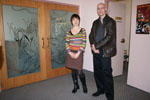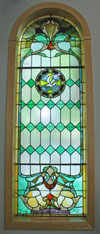We at Toronto United Mennonite Church tell many stories: from the Scriptures, of the people of God, the stories of Anabaptists, those drawn from our collective memories, and of our own congregation. The walls of our meetinghouse may not speak aloud, but apply a little imagination and you’ll find many of the objects within it have their own stories to tell.
There’s history behind many of the beautiful, symbolic, and even utilitarian items found in our building. You may find this a fun introduction to some of the things that TUMCers cherish.
SANCTUARY
Etched glass doors: The windows in the doors to the sanctuary are part of a generous bequest from former adherents Henry and Anne Peters. Most of it went to the church’s bursary fund, the Mennonite centre in the Ukraine and future capital projects. The last 10 percent, set aside for something to beautify our worship space, proved controversial. Some wanted to add stained glass, while others remembered the conscious decision to use clear glass in the church’s construction to symbolize openness. Others believed any such project was contrary to good stewardship. Otto Tiessen led a small committee that spent many hours researching historical church and Mennonite art and gathered opinions on what should appear on the doors. He also researched glass artisans. The committee concluded that etched glass could create an intriguing parable, as the artist Marc Chagall described it. Glass is invisible but what makes windows come to life is refracted light that pours through them, the light of God. Also, the thick art glass was both safer and more soundproof than plain glass doors. Thus it became the memorial project “acceptable to both the Marys and the Marthas among us,” church treasurer Tobi Thiessen chuckled at the unveiling. The design was created by Otto’s niece, artist Sharon Tiessen, and realized by Toronto master craftsman Tom Smylie. It features symbols of faith that include fish, doves, wheat and joyous human figures in a lively, contemporary design. A flowing ribbon that symbolizes the Spirit unifies the four doors. As Sharon Tiessen’s commented at the unveiling in spring 2007, the composer Anton Bruckner said that art has its origin in God and therefore must lead back to God. “It is my most sincere prayer that this humble offering will in some way lead you to God.” The doors delight both adults and youngsters who enjoy the tactile aspect of the doors as much as they do the beauty of its design.
Stained glass window: Mennonite church buildings are traditionally simple for theological reasons, with little iconography, art, or even colour. When our current building was erected in 1996, we made a conscious decision to stick with clear glass as a symbol of our openness and simplicity of worship. People walking by on Queen St. on a Sunday morning can easily peer in and see and hear us worshipping. So why is there an arched stained-glass window in our back corner? That represents other traditional Mennonite values like frugality, and not wasting resources. While designing our building, architect and TUMC member Victor Heinrichs was also working on another project. A Mennonite group in Elmira was converting a former Catholic church into a chapel and apartments for seniors. The priest in charge was asked whether they wanted to keep the stained glass windows. No, he said. Victor asked for one and proposed putting it on the Queen St. facade. The congregation liked the window, but wanted it in a less central position. The dedication at the bottom was left as it was out of respect for the original donor. But the central medallion was replaced with a more Anabaptist-looking dove. Voila! A Mennonite window with a Catholic donor!
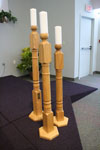
Candle-stands and lecterns: The set of hand-turned wooden pillars was a gift from the Warden Woods Mennonite Church when it disbanded, along with the small lectern carved with the Mennonite Church dove logo. For Warden Woods members who subsequently joined TUMC, both represent a continuation of their lives as part of that community. The less-ornate portable lectern was built by Henry Neufeld.
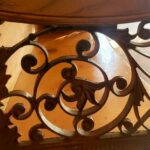
Ornate wooden bench: The small but fancy pew that sits in the lobby has a history longer than TUMC. Where it came from isn’t clear –– possibly an old church building that donated it to the Salvation Army store. It’s the last survivor of a set of recycled pews used during TUMC’s years at 140 Victor St., the house the fledgling congregation purchased in the 1940s to serve as a combination meeting place and manse. Look for its ornate wrought-iron side pieces. Another set of pews was purchased when TUMC erected its first building at 1774 Queen East in 1956 –– the fruit of a fundraising effort that involved a travelling choir. Those pews were sold when our current building was erected. (Some longtime church members regret that none were kept.) The old pew remains as a reminder of the earliest days of TUMC.
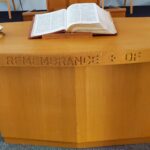
Communion table: The table, carved with the words “Do This in Remembrance of Me,” was donated by the children of Isaak Lehn, one of TUMC’s founding fathers, in memory of their dad, who was killed in a traffic accident in 1957.
Large Bible: This central item on our Communion table, usually displayed opened to the main scripture of the day, was a gift from the late Lena and Jim Braden, founding members of TUMC.
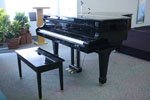
Grand piano: Out beautiful grand piano was purchased a couple of years before our old building came down and was stored while the new church went up. Several professional musicians in our congregation, including Bob Loewen and Jenny Regehr, had chosen it, first playing it in a series of fundraising concerts to pay for it. It replaced the old upright model that sits in on the third floor, whose provenance is unclear but has probably been with us since the days of meeting at 140 Victor St. (One guess is that it came from the old Menno House, a residence set up to meet the needs of young men coming to Toronto for studies.)
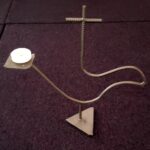
Metal Peace Dove: The peace dove candle holder was crafted out of rebar and steel by Vic Janzen and shared with us by his daughter Melana. This is one of several shared with churches in Saskatchewan to hold a congregation’s Peace Candle.
Artworks in the sanctuary: All of these are the work of professional artists who have been part of our community.
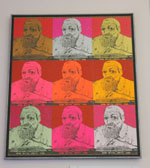
• Pop-art Menno: Who’d have thought to bring an Andy Warhol sensibility to the 16th-century engraved image of Menno Simons, the Anabaptist leader for whom our spiritual forefathers were nicknamed? The colourful large-scale work, most often noticed while leaving the sanctuary, is by Harvey Braun, a former TUMC member who served for some time as the artist in residence at John Braun’s pottery works in Kitchener. Ironically perhaps, he donated his eye-popping Mennos to the church in the late ‘90s, after deciding to join the Quakers.
• String art piece in shades of blue and grey: This piece, on the theme of “inclusivity,” is the work of Marta Armin, a late member of TUMC, who also designed the logo for the St. Clair O’Connor Community.
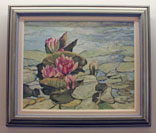
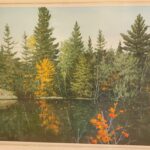
• Forest landscape: This piece was painted Bill Huebert, a founding member of TUMC and lifelong professional artist.
• Floral painting: This piece is by the late Helen Sawatsky.
ITEMS THAT APPEAR OCCASIONALLY
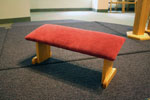
Kneeling bench: Used primarily for baptisms, this handcrafted bench with the rich red upholstery was a parting gift from David Brubacher, our interim pastor in the years 2007-2009, whose second vocation is finish carpentry. When it was noted that we lacked small tables to use for Communion and other purposes in the sanctuary, he also knocked together some easily disassembled tables using screw-on legs and the tops of old school desks he happened to have in his basement.

Communion sets: TUMC has two of these, but one has a particularly interesting history. The slightly dented silver set, with a cross that’s just a titch off-kilter on top, has two inscriptions on it. One says: “Presented to the First Evangelical Lutheran Church By the Home Social Club Easter 1924.” The other: “Purchased by Toronto United Mennonite Church 1942 – Engraved on occasion of 25th Anniversary 1973-74.” The set is a legacy of the earliest years of the congregation, founded as the Toronto Mennonite Mission, when it was based in the congregational hall of the German-speaking Lutheran church on Bond St. (adjacent to the Ryerson University campus).
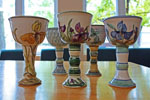
Communion cups: The colourful pottery chalices with an iris motif that we use on some occasions were crafted by Dorothy Martens of New Hamburg, a well-respected pottery artist.
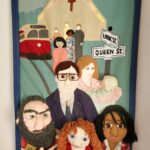
Fabric art: A variety of banners made by members of the congregation, including in particular Denise Voth, make occasional appearances in our sanctuary. A cityscape made by Erna Huebert features the CN Tower and other images iconic to Toronto. A smaller fabric art piece that hangs in a niche next to the north door was made by Dawn Lambert, who attended TUMC with her husband, Herman Cornelsen, for some time when they lived in Toronto. Dawn has taught graphic design at Humber College for many years.
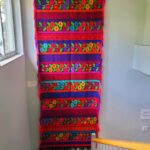
Take a moment to look up the northeast stairwell, outside the New Life church, to see the beautiful tapestry hanging. It was created over six months by Conchita Oax who lives in a small village in Mexico. It was purchased and donated by Betty Puricelli and donors from TUMC in 2023, as a symbol of our connection as communities of faith: Toronto Mennonite New Life Church and TUMC.
Peace Lamp: This simple handmade pottery oil lamp has counterparts in many Mennonite churches around North America and has been presented as a symbolic gift to many others, most recently to the archbishop of the Syriac Orthodox Church in celebration of 25 years of Mennonite assistance to Christians in Syria. As the Iraq War began in 2003, congregations were encouraged to light one of these lamps each Sunday as a reminder to pray and work for peace.
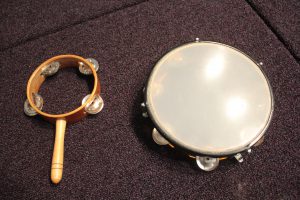
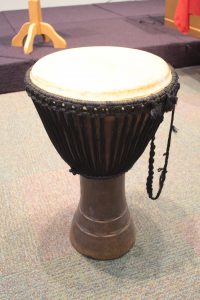
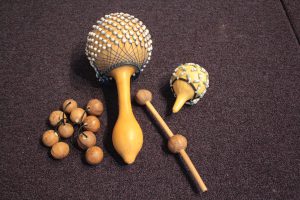
International instruments: Many of the drums and rhythm instruments we use occasionally during services were purchased from Ten Thousand Villages, the fair-trade organization that TUMC supports, but others have more specific origins. A djembe (African drum) and calabash shakers were a gift from Virginia Lepp, on her return from five years’ service with Mennonite Central Committee in Burkina Faso. Others were a gift of the late Edith Kool.
ELSEWHERE IN THE BUILDING
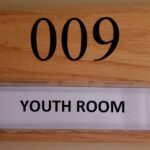
Door signs: Many of the oak signs displaying room numbers and descriptions of their use throughout the building were made and installed by Greg Glista and his father-in-law, Bill DeFehr, who shared a fun story: “It was quite a project, but we enjoyed doing it,” Bill recalled. “However, at one point I noticed that one of the signs looked a little unusual. On closer look I noticed that Greg’s Catholic background was showing because the sign read: CONFESSIONAL AND PAPAL RELICS. I did my part and made the correction. I have to keep an eye on my Catholic sons-in-law!”
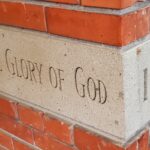
Cornerstones: You may have wondered about the two date-stones set into a small brick wall opposite the front entrance. This wall was one piece of the original 1956 building that was left in place when most of it was razed to be replaced by the new three-storey building in 1996. The early stone was donated by a Mennonite-owned memorial stones company in Kitchener-Waterloo. There’s a time capsule inside the wall . What it contains nobody seems to remember!
Utilitarian items:
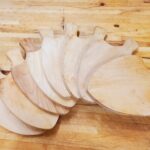
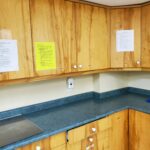
The basement servery cupboards were salvaged from the original kitchen of the 1956 church; the new kitchen cabinetry was built by Don Willms, a regular attender at the time. The cheese boards that often appear under hot dishes at potlucks were made by TUMC members in the St. Clair O’Connor Community woodworking shop, with the intent of using them in the Good Friday suppers that began in the late 1980’s.
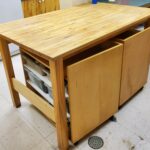
The rolling tables in the lobby were made and donated by an instructor at Central Tech.

Upper Room sign: If you go to our third floor, you’ll see a wooden sign hanging at the entrance to the sanctuary of the Spanish speaking New Life Church. It was made by Harvey Braun to designate an earlier upper room above the sanctuary in the old church building. The New Life Church congregation, some of whom were refugees who’d suffered torture and detention in dark prisons, wanted to worship in an uplifting place full of light. They chose the third floor of our new space. Founding pastors Adolfo and Betty Puricelli welcomed the sign as their entrance to this new upper room.
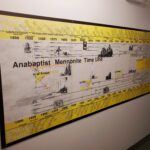
Anabaptist history chart: You’ll find this helpful chart in the hall to the pastor’s offices. It was a gift from Otto Tiessen. For many years he was away from the Mennonite world working as a diplomat. He felt it was important to connect with our spiritual and historical roots as a worldwide Christian movement. The chart portrays the tangled interconnections between various strands of Anabaptists.
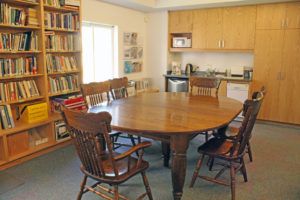
Table: This beautiful oak table, which can be expanded to seat 15 or more, was a gift from Shelley Lepp on the occasion of our renovation project in 2016. It encapsulates many of our congregation’s traditions and values of community, hospitality and mutuality. It’s a place to sit down together to eat, chat, and watch youngsters play. You’ll find it in our basement.

